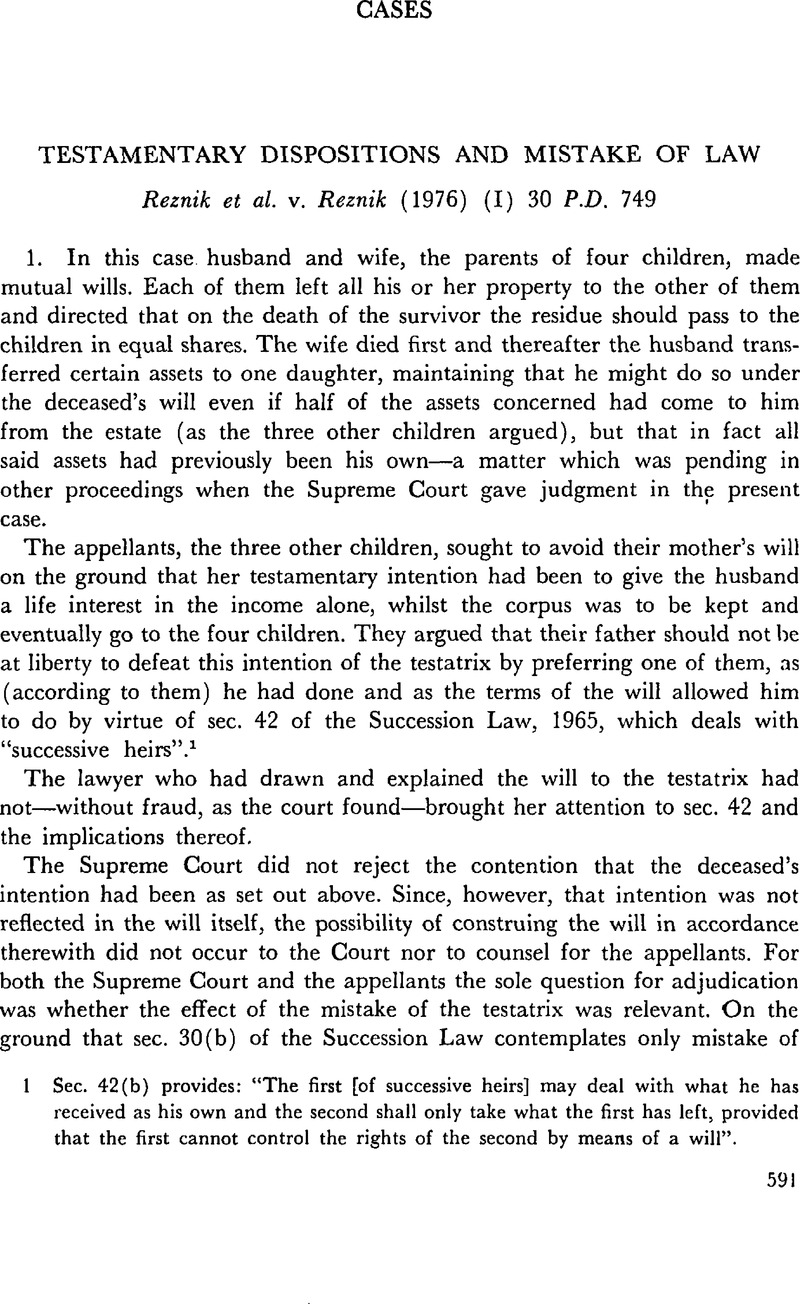No CrossRef data available.
Article contents
Testamentary Dispositions and Mistake of Law
Published online by Cambridge University Press: 12 February 2016
Abstract

- Type
- Cases
- Information
- Copyright
- Copyright © Cambridge University Press and The Faculty of Law, The Hebrew University of Jerusalem 1976
References
1 Sec. 42(b) provides: “The first [of successive heirs] may deal with what he has received as his own and the second shall only take what the first has left, provided that the first cannot control the rights of the second by means of a will”.
2 Ministry of Justice, Proposal for a Bill of the Succession Law (1952) 88.Google Scholar
3 See per Lord Wensleydale in Abbot v. Middleton (1859), 7 H.L.C. 68, 114: “The use of the expression that the intention of the testator is to be the guide, unaccompanied with the constant explanation that it is to be sought in his words, and a rigorous attention to them, is apt to lead the mind insensibly to speculate upon what the testator may be supposed to have intended to do; instead of truly attending the true question, which is what that which he has written means. The will must be expressed in writing and writing only is to be considered”. Cf. L.C., Viscount Simon in Perrin v. Morgan, [1943] A.C. 399, 406Google Scholar; Knight Bruce, L. J. in Lowe v. Thomas (1954), 5 De G. M. & G., 315, 317Google Scholar; and see Re Gouk, [1957] 1 W.L.R. 493. (But see in a more or less opposite direction, inter alia, the observations of Cairns L.C. and Lord Heatherley in Fulton v. Andrew (1870), 7 H.L.R. 448, 460, 469; and Garnett-Botfield v. Garnet-Botfield, [1901] P. 335 and Gregson v. Taylor, [1917] P. 256, 261, cited with approval in Belan v. Executors of the Will of R. Litwinsky (1957) 48 P.M. 369, 384; and Re Phelan, [1971] 3 W.L.R. 888, upon which the present appellant relied). English law also denies in general the power of the court “to rectify a will in order to give effect to what the testator might have done if he had thought about it”: Re Hammersley, [1965] Ch. 481.
4 For France, see Ripert, and Boulanger, , Traité de droit civil, IV (1959)Google Scholar, no. 2062; for Germany, Kipp-Coing, Erbrecht (12 Bearb. 1965), pp. 98 et seq.; for Italy, Messineo, , Manuale di dir. civ. e commerc. (9 ed. 1962) VI, p. 202Google Scholar; Azzariti, “Successione (dir. civ.): Success, testam.”, no. 33, Noviss. Dig. Ital.; for Switzerland, Tuor, , Das Schweiz. ZGB (5 ed. 1948), § 62 II, p. 342.Google Scholar
5 Raape, in Deutsche Notar-Zeitschr., 1935, 369Google Scholar; Haegele, ibid., 1954, 289 et seq.
6 Where the mistake of the testator is not in question and the problem is to de termine the provisions of the will in accordance with his intention, sec. 31—disenabling rectification after the passage of one year from the date the mistake became known to the testator without his doing anything about it—will have no application.
7 Emphasis added.
8 Sec. 30:
(a) A testamentary provision made under duress, threats or undue influence or as a result of trickery or fraud is void.
(b) Where a testamentary provision is made by reason of error and it is possible to determine clearly what the testator would have directed in his will but for the error, the Court shall amend the terms of the will accordingly; where this is impossible, the testamentary provision is void.
9 [1970] 2 W.L.R. 865, 874.
10 (1882), 7 A.C. 192, 199–200.
11 Regarding mistake in a will, see, e.g., Palandt, , Bürgerlisches Gesetzbuch (33 Aufl. 1974) para. 2078, p. 1733Google Scholar; Planiol, & Ripert, , Traité prat. de droit civ. français, V (Trasbot) (1933), no. 183, p. 192.Google Scholar




